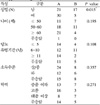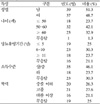2. United Kingdom Prospective Diabetes Study (UKPDS) Group. Intensive blood-glucose control with sulphonylureas or insulin compared with conventional treatment and risk of complications in patients with type 2 diabetes (UKPDS 33). Lancet. 1998. 352:837–853.
3. DeLawter DW, Moss JM, Tyroler S, Canary JJ. Secondary failure of response to tolbutamide treatment. JAMA. 1959. 171:1786–1792.

4. United Kingdom Prospective Diabetes Study Group. Overview of 6 years' therapy of type II diabetes: a progressive disease (UKPDS 16). Diabetes. 1995. 44:1249–1258.
5. Wright A, Burden AC, Paisey RB, Cull CA, Holmann RR. UK Prospective Diabetes Study (UKPDS) Group. Sulfonylurea inadequacy: efficacy of addition of insulin over 6 years in patients with type 2 diabetes in the UK Prospective Diabetes Study (UKPDS 57). Diabetes Care. 2002. 25:330–336.

6. American Diabetes Association. Standards of medical care in diabetes. Diabetes Care. 2000. 23:1130–1136.
7. The Diabetes Control and Complication Trial (DCCT) Research Group. Effect of intensive treatment of diabetes on the development and progression of long-term complication in insulin-dependent diabetes mellitus. N Eng J Med. 1993. 329:977–986.
8. Ohkubo Y, Kishikawa H, Araki E, Miyata T, Isami S, Motoyoshi S, Kojima Y, Furuyoshi N, Shichiri M. Intensive insulin therapy prevents the progression of diabetic microvascular complication in Japanese patients with non insulin dependent diabetes mellitus: a randomized prospective 6-year study. Diabetes Res Clin Pract. 1995. 28:103–117.
9. Shichiri M, Kishikawa H, Ohkubo Y, Wake N. Longterm results of the Kumamoto Study on optimal diabetes control in type 2 diabetic patients. Diabetes Care. 2000. 23:suppl 2. B21–B29.
10. Wake N, Hisashige A, Katayama T, Kishikawa H, Ohkubo Y, Sakai M, Araki E, Shichici M. Cost effectiveness of intensive insulin therapy for type 2 diabetes: a 10-year follow-up to the Kumamoto Study. Diabetes Res Clin Prac. 2000. 48:201–210.
11. Koro CE, Bowlin SJ, Bourgeois N, Fedder DO. Glycemic control from 1988 to 2000 among U.S. adults diagnosed with type 2 diabetes. Diabetes Care. 2004. 27:17–20.
12. Chuang LM, Tsai ST, Huang BY, Tai TY. Diabcare-Asia 1998 Study Group. The status of diabetes control in Asiaa cross-sectional survey of 24317 patients with diabetes mellitus in 1998. Diabet Med. 2002. 19:978–985.
13. Resnick HE, Foster GL, Bardsley J, Ratner RE. Achievement of American Diabetes Association clinical practice recommendations among U.S. adults with diabetes, 1999-2002: the National Health and Nutrition Examination Survey. Diabetes Care. 2006. 29:531–537.

14. Korytkowski M. When oral agents fail: practical barriers to starting insulin. Int J Obes Relat Metab Disord. 2002. 26:S18–S24.

15. Skinner TC. Psychological barriers. European Journal of Endocrinology. 2004. 151:T13–T17.

16. Davis SN, Renda SM. Psychological insulin resistance; overcoming barriers to starting insulin therapy. Diabetes Educator. 2006. 32:supple 6. S146–S151.

17. William H. Polonsky, Richard A. Jackson. What's so tough about taking insulin? addressing the problem of psychological insulin resistance in type 2 diabetes. Clinical diabetes. 2004. 22:147–150.

18. Polonsky WH, Fisher L, Guzman S, Villa-Caballero L, Edelman SV. Psychological insulin resistance in patients with type 2 diabetes: the scope of the problem. Diabetes Care. 2005. 28:2543–2545.

19. Hunt LM, Valenzuela MA, Pugh JA. NIDDM patients' fears and hopes about insulin therapy: the basis of patient reluctance. Diabetes Care. 1997. 20:292–298.

20. Polonsky WH, Fisher L, Dowe S, Edelman S. Why do patients resist insulin therapy? Diabetes. 2003. 52(abstr):A417.
21. United Kingdom Prospective Diabetes Study Group. Relative efficacy of randomly allocated diet, sulphonylurea, insulin, or metformin in patients with newly diagnosed non-insulin dependent diabetes followed for three years. BMJ. 1995. 14:83–88.
22. Okazaki K, Goto M, Yamamoto T, Tsujii S, Ishii H. Barriers and facilitators in relation to starting insulin therapy in type 2 diabetes. Diabetes. 1999. 48(abstr):A1319.
23. Funnell MM, Kruger DF, spencer M. Self-management support for insulin therapy in type 2 diabetes. The Diabetes Educator. 2004. 30:274–280.

24. Bashoff EC, Beaser RS. Insulin therapy and the reluctant patient, overcoming obstacle to success. Postgraduate Medicine. 1995. 97:86–96.
25. Brunton SA, Renda SM, Davis SN. Overcoming psychological barriers to Insulin use in type 2 diabetes. Clinical cornerstone. 2006. 8:supple 2. S19–S26.

26. Bogatean MP, Hâncu N. People with type 2 diabetes facing the reality of starting insulin therapy: factors involved in psychological insulin resistance. Practical Diabetes Int. 2004. 21:247–252.

27. Meece J. Dispelling myths and removing barriers about insulin in type 2 diabetes. The Diabetes Educator. 2006. 32:suppl 1. S9–S18.

28. Bolli GB. Physiological insulin replacement in type 1 diabetes mellitus. Exp Clin Endocrinol Diabetes. 2001. 109:suppl 2. S317–S332.

29. Mollema ED, Snoek FJ, Heine RJ, van Der Ploeg HM. Diabetes fear of injection and self-testing questionnaire: a psychometric evaluation. Diabetes Care. 2000. 23:765–769.







 PDF
PDF ePub
ePub Citation
Citation Print
Print





 XML Download
XML Download